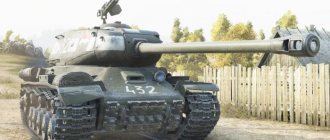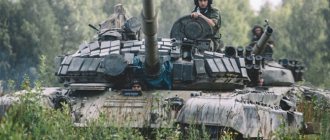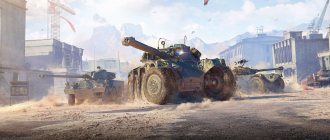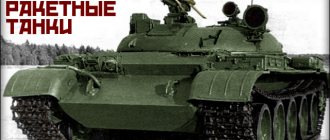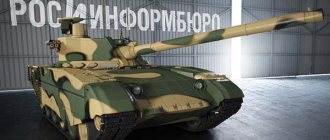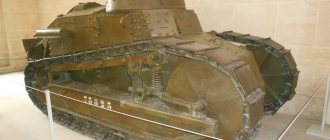The idea of creating a tank that would be able to destroy any enemy defense without harm to itself more than once arose in the thoughts of military leaders. Work on creating a super tank was carried out in the 30s of the last century by specialists from many countries, including the USSR. The idea of super-heavy battleships was based on the assumption that increasing the size of the vehicle and the thickness of its armor would give a significant advantage in its power and security.
Land battleship: gigantic super tank TG 5
In early 1930, at the request of the Soviet Union, German engineer Edward Grote was invited to assist in the design of armored vehicles. He developed several variants of heavy vehicles, one of which was the “land battleship”.
This huge vehicle, according to the author’s idea, was supposed to have six turrets with various types of weapons, 300 mm frontal armor, three tracks, four ship engines with a power of 24,000 hp. With. every.
The steel giant weighing 1,000 tons had to be serviced by 40 people. But due to the excessive bulkiness and complexity of the design, the implementation of this project was unrealistic.
The first-born of tank building Mark I
The first British heavy tank, the Mark I, became the ancestor of the British diamond tank family. This tank went down in history as the first one used in the battle on the Somme River on September 15, 1916.
The Mark I was produced in two configurations - male and female. On the male version, in addition to machine gun armament, two 57-mm cannons were installed.
During the war, British engineers modified the vehicle, and the Mr IV and Mr V tanks were in service with various armies around the world until the early 1930s.
Problems of super heavy tanks
All pre-war developments of heavy tanks showed that there was no point in creating super-heavy vehicles weighing several hundred tons. Because of their clumsiness, they become easy prey for enemy artillery.
Due to their heavy weight, their delivery to their destination is impossible in assembled form. When moving independently, the chassis experiences enormous loads and quickly fails.
Changes were made to the concept of building heavy tanks. The design teams were tasked with creating a combat vehicle weighing about 100 tons. Work on projects for new vehicles began to boil in early April 1941.
The first “swallows” in this project were the KV-4 and KV-5 tanks. Heavy vehicles weighing 80 and 100 tons were identical, differing only in the thickness of the armor. Their launch into production was prevented by the outbreak of the Great Patriotic War.
Car evaluation[edit]
Like most super-heavy tanks developed in the 1920s and 1930s. different countries of the world, the T-42 had almost no practical usefulness. Its enormous size and weight made the tank an excellent target, despite its anti-ballistic armor. The dynamic characteristics of the tank were also questionable. In addition, there was the difficult problem of delivering tanks of this size and weight to the front line and their combat operation (for example, crossing rivers with such a vehicle over bridges was out of the question). Finally, the very first rough calculations of the cost of the tank brought frightening results. Considering everything said above, even the objectively very powerful weapons of the T-42 did not play a decisive role. Thus, the tank had no advantages over the T-35, which was ultimately chosen by the military for adoption.
However, it is worth noting a number of progressive solutions used by Grotte when developing the tank. These include, for example, the presence of a commander's cupola and the possibility of air defense of the tank, as well as the widespread use of electric and servo drives.
Post-war development of super heavy tanks
In the post-war period, work on the creation of heavy tanks continued. The IS-7 tank became one of the most powerful and heaviest. The vehicle weighed 68 tons and had excellent armor protection. Engine 1,050 hp. With. allowed the car to accelerate to 60 km/h on the highway.
In 1957, another development of Leningrad tank builders appeared - a tank called “object 279”. Although it does not fall under the term super-heavy in terms of weight, the thickness of its armor allows us to rank it in this category of armored vehicles. The thickness of the turret walls is 30.5 cm, the frontal armor is 27 cm. This protection is obtained thanks to the special design of the hull, reminiscent of a flying saucer.
The tank was equipped with a 130 mm rifled gun. To reduce ground pressure, the tank is equipped with two twin tracks, but the use of such a solution reduced its maneuverability, which became an obstacle to putting it into mass production.
At the end of the 60s, work in the USSR to create super-heavy tanks was stopped.
Armament
In the history of the real E-100 prototype, it never came to the point of installing weapons, although the question of which combat modules to install on this vehicle was worked out for a long time. Developers from the Krupp concern envisaged as many as three main gun options for equipping the super-heavy tank, including a self-propelled gun version with a 173-mm cannon.
The 128 mm KwK 44 L/55 gun was intended to be the original version, originating from an anti-aircraft gun of a similar caliber. In addition to it, the 75-mm KwK44/1 L/70 gun was intended to destroy infantry outside cover and weakly protected enemy vehicles. The ammunition capacity of 128 mm caliber shells was 50 rounds, and 100 rounds of 75 mm caliber shells.
KwK 44 L/38 cannon and machine gun
It was decided to make the 150-mm KwK 44 L/38 tank gun the main armament of the serial E-100. It was precisely this version of the main caliber gun for super-heavy tanks that Hitler insisted on. Even in the early period of World War II, the Krupp company was able to produce a 150-mm gun with an initial projectile speed of 600-800 m/s, based on a railway platform. But all attempts to adapt their design for tank weapons were unsuccessful.
It also turned out to be impossible for the Krupp concern to finalize the integration of a single German MG34 machine gun into the E-100 tank turret. The 7.92 mm MG42 machine gun was intended only for transportation in the tank.
List of models [edit]
Great Britain
- TOG 1: 80 tons; built 1940; designed for ground conditions similar to those in World War I; one prototype.
- TOG II*: 80 tons of improved TOG1 design; one prototype.
- Flying Elephant: World War I design weighing 100 tons; not built.
- Heavy assault tank Tortoise: 80 tons, designed for attacking fortifications. 6 prototype vehicles completed.
- None of the TOG prototypes were built as they were designed; if sponsons were added and a corresponding turret was attached, their weight would be different.
France
- Char 2C: 69 tons; 10 built, operated from 1921 to 1940; obsolete during World War II, 9 were destroyed to prevent capture and the remaining 1 was displayed in Berlin as a trophy. Char 2C bis: 72 tons; a modified Char 2C with a 155mm howitzer and a different turret; one Char 2C was converted to this variant, but was later returned to its original configuration
German Empire
- K-Wagen: 120 metric tons; two were almost completed when the First World War ended. Both were demolished.
Nazi Germany
- Panzer VII Löwe: about 95–100 tons; canceled in favor of Maus.
- Panzer VIII Maus: 188 tons, two prototypes. Both were captured by the Soviet army, although one was partially destroyed. Their composition can be seen in the Tank Museum in Kubinka.
- Panzerkampfwagen E-100: 140 tons; One unfinished building at the plant was captured by the British and later scrapped.
- Panzer IX: Concept by Signal.
- Panzer X: Another concept from Signal
. - Landkreuzer P. 1000 Ratte: 1000 tons; canceled, evidence has not begun.
- Panzerkampfwagen E 75 Standardpanzer: 92 tons; Design concept only.
Japanese Empire
- OI series "Super heavy tank": 120 tons. One prototype was allegedly produced in 1943. [3] According to another source, the OI project was canceled before the 120-ton prototype was completed. [4]
- “Super-heavy tank”: modification of the OI super-heavy tank with four turrets. Only a project.
Russian empire
- Tsar Tank: A giant wheeled (about 9 m in diameter) three-wheeled gun platform from 1914 that was abandoned due to its vulnerability to artillery.
- Mendeleev tank: 1911–1915 design for a heavily armored "land ship" that would have weighed about 170 tons if built.
Soviet Union
- T-42 (Tank Grote or TG-V): 100 tons with a 107 mm gun and four turrets. Models and drawings were made [5]
- KV-4: Project 1941. Proposed tank weighing 90–100 tons, carrying a 107 mm gun and a 45 mm or 76 mm auxiliary gun; Various layout options were considered, with a hull-mounted 107 mm and 76 mm turret chosen as the final option. [6] Feasibility study stage only.
- KV-5: another project of a 100-ton tank in the Kliment Voroshilov series. Armed with the same 107 mm cannon in a large KV-2 type turret and two 12.7 mm machine gun turrets (one on the forward hull, one on the top of the main turret); was equipped with two V2 diesel engines due to the lack of a 1200 hp engine during wartime. The project was stopped due to the blockade of Leningrad and canceled because nothing was built.
United States
- T28 Super Heavy Tank: Also known as the T95 GMC, designed to attack heavy fortifications. 86.2 metric tons; 2 prototypes built immediately after World War II; according to the layout of the self-propelled gun. Very similar to the British tortoiseshell. It can now be seen on display at Fort Benning, Georgia.
KV-6 captured by the Germans from 124tbr.
repair attempt
| Photo No. 70 turnover | The camouflage on the left side of the tower is clearly visible. This is probably one of the first photographs of this tank from the Germans. All other photographs contain houses and very little forest. |
| Photo No. 71 | The damage to the first and second rollers is clearly visible. |
| Photo No. 74(1) Photo No. 74(2) Photo No. 74(3) | Photos No. 74(1) and No. 74(2) were taken from the same negative, but there are different versions on the Internet. From photo No. 74(1): The second tank (came in tow). The distant plan is clearly visible - the roofs of the houses. Conclusion: the territory where these two tanks are located is on a hill. From photo No. 74(3): (Picture enlarged 3 times!) The shooting angle is identical to the other two photographs. The photo shows the third(!) tank. We can definitely say that this is not a shielded HF. If we assume that this is some kind of repair depot, then this KV may well turn out to be from another section of the Lening Front. (i.e., its belonging to the 124th brigade cannot be unambiguously determined!) In addition, if the tank is in the repair zone and the first two tanks were put into operation quite easily, then what prevented the third tank from being restored? The photo was in a single block with photo No. 78(2) |
| Photo No. 75(1) Photo No. 75(2) | Repair in the field. There is an opinion and assumption that Russian tank crews are visible in photo No. 75(2). I cannot judge how true this is, because with the same degree of clearance these could be German tank crews. In any case, the exact answer will be provided by documents or memories of participants in the events. For example, if a message is found that crew members were captured and they were involved in repairing tanks, then everything will definitely fall into place. |
| Photo No. 78(1) reverse Photo No. 78(2) | From photo No. 78(1): Perhaps the photo shows a tank before repairs, but..... (see reasoning below). The damage and camouflage of the turret indicate that this is the same tank as in the previous photographs. The house on the right resembles the house in photo No. 75. A house with a chimney indirectly indicates an industrial area or a boiler room. From photo No. 78(2): (Picture enlarged 3 times!) The photo shows the process of repairing the chassis (the roller is missing). But at the same time you can see a light snow covering the ground. The shooting angle almost exactly matches photograph No. 78(1). The photo was in a single block with photo No. 74(3) |
| Photo No. 79 | The photo had the caption “Krasnoe Selo” (should we believe this? and which KV is it (of the two)?). |
Unlucky defender of the German General Staff
Work on the topic of super-heavy tanks and self-propelled guns at their base in Germany was officially curtailed in the second half of July 1944. In practice, the order of the 6th Department of the Armaments Department to hand over the reserve hulls and turrets for scrap metal, issued on July 27, was not even carried out. The Krupp concern hid the existing reserves in warehouses, where they were later discovered by the British and Americans.
On August 19, 2019, Krupp management informed Porsche that the Armament Service had given instructions to stop work on the Typ 205 project. The specialists who assembled the second prototype left Böblingen. However, this did not mean that the tests of Pz.Kpfw. Maus are over. In the fall, the second prototype of the tank, designated Typ 205/II, received a new engine. Instead of the gasoline Daimler-Benz MB.509, the car received a diesel MB.517. This engine was first supposed to be installed on a tank in the fall of 1942. This time the engine was available in a turbocharged version, thanks to which its power increased to 1200 horsepower. Exactly when the MB.517 was installed in the tank is unknown, but correspondence dated December 1, 1944 states that the engine was installed in a Typ 205/II and had not yet been tested.
By the way, Porsche managed to install the engine bypassing the SS, which oversaw its development. When the SS men realized it, it turned out that one of the two engines, each of which cost the Germans 125,000 Reichsmarks, was already in the super-heavy tank.
The last “lifetime” photograph of prototypes of the Pz.Kpfw. Maus. It was made in the warehouse of the Rukhleben railway station in January 1945
The only effective way to stop work on fine-tuning the super-heavy tank was to confiscate Porsche’s “favorite toy.” At the end of December 1944, both models of Pz.Kpfw. The Maus were transported from Böblingen to a warehouse near Ruhleben railway station on the western outskirts of Berlin. They stayed there at least until the end of January 1945, after which they were sent to the Kummersdorf training ground, located 25 kilometers south of Berlin. Here, a technical description of the second prototype (at the same time the only one with a turret and weapons) was compiled, after which the tanks were placed in a hangar, where Porsche could no longer reach.
What happened to these vehicles between January and March 1945 is unknown. There is no reliable evidence that they participated in any trials. However, it was at this time that shelling tests of the first prototype, designated Typ 205/I, could have been carried out.
This is how Soviet troops discovered Typ 205/II
In March 1945, Typ 205/II was delivered under its own power to Wünsdorf, 2.5 kilometers south of Zossen, where the headquarters of the German General Staff was located. In Soviet documents, by the way, this place was often designated as Stamlager. The vehicle was included in the forces that guarded the headquarters; the outer ring of Berlin's defense also passed through the Zossen area.
Much has been written about how the Typ 205/II was used in the Battle of Berlin, and many copies have been broken in disputes on this topic. With a certain degree of certainty, we can only talk about who the Porsche super-heavy tank could potentially fight with. Units of the 3rd Guards Tank Army were advancing on Berlin from the southeast. On April 21, 1945, the 6th Guards Tank Corps, which was part of this formation, reached the Tophin-Zelensdorf line. There was very little left to Zossen; it was captured during a night attack from April 21 to 22. Thanks to the confusion, the headquarters of the German General Staff was able to leave Zossen at the time it was occupied by the 6th Guards Tank Corps. According to the memoirs of the commander of the 53rd Guards Tank Brigade V.S. Arkhipov, before leaving, the SS shot some of the staff officers, the rest were evacuated.
He is from the stern, in the background is a destroyed cinema building
As for the Pz.Kpfw. Maus, then his fighting career turned out to be short and sad. During maneuvering, an engine breakdown occurred. The immobilized car ended up at the intersection of Zeppelinstrasse and Zerensdorferstrasse in Wünsdorf, not far from the headquarters. She stood up in such a way that it was impossible to use her even as a stationary firing point. As a result, its crew simply had no choice but to blow up the tank. In a word, no heroic defense happened; the super-heavy tank turned out to be a colossus with feet of clay.
The damage on the left side was minimal. In the background you can see the guard service building, now in its place there is a travel agency
In Arkhipov's memoirs Pz.Kpfw. Maus V2 is mentioned, but with a clear distortion of the picture:
“In the town we captured three huge tanks. The hatches were open, everything was in order inside, even the ammunition was prepared for battle - the factory grease had been removed from it. The tanks were so large that even the “Royal Tiger” would have seemed like a wedge next to them. The tower is flat as a pancake. The tank is armed with a 155 mm cannon. It looks like a very impressive car, but, drawing an analogy with the “Royal Tiger,” I am sure that its driving performance was poor.”
The explosion also tore off the additional fuel tank. The bathhouse building is visible in the background
Either the literary editor mixed together the Pz.Kpfw captured at the Sandomierz bridgehead. Tiger II and Pz.Kpfw. Maus, or Arkhipov had already mixed something up, but the reality turned out to be different. The Red Army received the tank already blown up. The force of the explosion tore off the right side of the hull and tore off the turret along with the turret ring.



